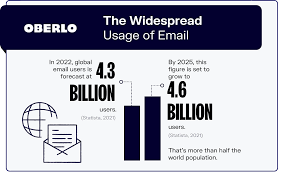Email Marketing Tools: Boosting Your Business Communication
In today’s digital era, effective communication is key to the success of any business. And when it comes to reaching your target audience, email marketing remains one of the most powerful and cost-effective strategies. However, managing email campaigns manually can be time-consuming and challenging. That’s where email marketing tools come in.
Email marketing tools are software solutions designed to streamline and automate your email marketing efforts. These tools offer a wide range of features and functionalities that simplify the process of creating, sending, and tracking emails. Let’s explore some of the top benefits these tools bring to your business:
- Easy Email Creation: With user-friendly drag-and-drop editors, email marketing tools allow you to create professional-looking emails without any coding knowledge. You can choose from a variety of pre-designed templates or customize them to match your brand identity.
- Contact Management: Maintaining an organized contact list is crucial for effective email campaigns. Email marketing tools provide contact management systems that allow you to segment your audience based on demographics, interests, or past interactions. This ensures that your messages are targeted and relevant.
- Automation: One of the biggest advantages of using email marketing tools is automation. You can set up automated workflows for various scenarios like welcome emails, abandoned cart reminders, or birthday greetings. This saves time and ensures consistent communication with your subscribers.
- Personalization: Personalized emails have higher open rates and engagement levels. Email marketing tools enable you to dynamically insert subscriber information into your emails, creating a personalized experience for each recipient.
- A/B Testing: To optimize your email campaigns, A/B testing is essential. These tools allow you to test different subject lines, content variations, or call-to-action buttons to determine which version performs better. This data-driven approach helps refine your messaging strategy.
- Analytics and Reporting: Comprehensive analytics provided by these tools give you valuable insights into the performance of your email campaigns. You can track metrics like open rates, click-through rates, and conversion rates. This data helps you understand what works and what needs improvement.
- Integration: Email marketing tools integrate with other platforms like customer relationship management (CRM) systems or e-commerce platforms. This seamless integration allows you to sync data, automate workflows, and provide a cohesive customer experience.
- Compliance and Deliverability: Email marketing tools ensure compliance with anti-spam regulations by providing unsubscribe options and managing opt-outs. They also monitor deliverability rates, helping you maintain a good sender reputation and ensuring your emails reach the intended recipients’ inboxes.
Choosing the right email marketing tool for your business depends on your specific needs and budget. Some popular options include Mailchimp, Constant Contact, AWeber, and GetResponse. Consider factors like ease of use, scalability, pricing plans, and customer support when making your decision.
In conclusion, email marketing tools offer immense benefits to businesses looking to enhance their communication strategies. From simplifying email creation to automating workflows and providing valuable insights, these tools empower you to connect with your audience effectively. Embrace the power of email marketing tools today and take your business communication to new heights.
- Selecting the Perfect Email Marketing Tool for Your Business
- Maintaining a Relevant Email List: The Key to Success
- Enhancing Engagement with Personalised Emails
4
- Choose the right email marketing tool for your business needs – make sure it has all the features you need, like automated campaigns, templates, and analytics.
- Keep your email list up to date – regularly clean out old contacts and add new ones to ensure your messages are reaching the right people.
- Personalise emails – use dynamic content to tailor emails to each recipient’s interests and preferences for better engagement.
- Monitor email performance – track open rates, click-throughs, unsubscribes and other metrics to measure success and adjust campaigns accordingly.
- Test different strategies – try A/B testing or multivariate testing on elements such as subject lines or layout for maximum impact with minimal effort
Choose the right email marketing tool for your business needs – make sure it has all the features you need, like automated campaigns, templates, and analytics.
Choosing the Right Email Marketing Tool: A Recipe for Success
In the fast-paced world of digital marketing, email remains a powerful tool for businesses to connect with their audience. However, managing email campaigns manually can be a daunting task. That’s where email marketing tools come to the rescue. But how do you choose the right one for your business needs?
When selecting an email marketing tool, it’s vital to consider its features and functionalities. Here are some key elements to focus on:
Automated Campaigns: Look for a tool that offers automation capabilities. This feature allows you to set up automated workflows, saving you time and effort. Whether it’s sending welcome emails to new subscribers or nurturing leads through a series of targeted messages, automation ensures consistent communication with your audience.
Templates: An efficient email marketing tool should provide a variety of pre-designed templates or an easy-to-use drag-and-drop editor. Templates make it simple to create visually appealing emails without any coding knowledge. Ensure that the tool offers customization options so that your emails reflect your brand identity.
Analytics: Analytics play a crucial role in measuring the success of your email campaigns. Look for a tool that provides comprehensive analytics and reporting features. This allows you to track metrics like open rates, click-through rates, and conversions. With this data at your fingertips, you can refine your strategies and improve campaign performance.
Integration: Consider whether the email marketing tool integrates seamlessly with other platforms you use in your business, such as CRM systems or e-commerce platforms. Integration ensures smooth data syncing and enables you to automate workflows across different platforms, providing a cohesive customer experience.
Ease of Use: Opt for an email marketing tool that is user-friendly and intuitive. It should have a straightforward interface that allows you to navigate easily through its features without feeling overwhelmed. A tool that offers excellent customer support can also be beneficial if you encounter any challenges along the way.
Price: Evaluate pricing plans offered by different tools and choose one that aligns with your budget. Some tools offer free plans with limited features, while others provide more advanced features at a cost. Consider the value you will derive from the tool and select accordingly.
By carefully considering these factors, you can select an email marketing tool that caters to your specific business needs. Remember, the right tool will empower you to create automated campaigns, leverage customizable templates, and gain valuable insights through analytics. With the right email marketing tool in hand, you can take your business communication to new heights and achieve success in the digital landscape.
Keep your email list up to date – regularly clean out old contacts and add new ones to ensure your messages are reaching the right people.
Keeping Your Email List Fresh: The Key to Effective Email Marketing
When it comes to email marketing, one of the most crucial tips for success is to keep your email list up to date. Regularly cleaning out old contacts and adding new ones ensures that your messages reach the right people at the right time. Here’s why maintaining a fresh email list is essential for effective communication:
- Improved Deliverability: Over time, email addresses can become inactive or outdated. By regularly cleaning out old contacts, you can reduce the number of bounced emails and improve your deliverability rates. This means that your messages are more likely to land in your subscribers’ inboxes instead of getting lost in spam folders.
- Targeted Communication: As your business evolves, so do your target audience and their preferences. By periodically reviewing and updating your email list, you can ensure that you’re sending relevant content to the right people. Removing inactive subscribers or those who have shown no interest in your emails allows you to focus on engaging with those who are genuinely interested in what you have to offer.
- Higher Engagement Rates: A clean and updated email list leads to higher engagement rates. When you send targeted messages to an engaged audience, they are more likely to open, read, and interact with your emails. This boosts click-through rates, conversions, and ultimately helps achieve your marketing goals.
- Cost Efficiency: Many email marketing tools charge based on the number of subscribers on your list. By regularly cleaning out old contacts, you can optimize costs by only paying for active subscribers who are genuinely interested in hearing from you.
So how can you keep your email list up to date? Here are a few best practices:
– Remove inactive subscribers: Identify those who haven’t engaged with your emails for an extended period (e.g., six months) and consider removing them from your list.
– Provide easy opt-out options: Make sure every email includes an unsubscribe link, allowing recipients to opt out if they no longer wish to receive your communications. This helps maintain a healthy and engaged subscriber base.
– Encourage subscribers to update their preferences: Periodically send emails asking subscribers to update their preferences, ensuring that you have the most accurate and relevant information about them.
– Regularly add new contacts: Actively seek opportunities to grow your email list by implementing lead generation strategies. This could include offering valuable content, running targeted ad campaigns, or hosting webinars that require registration.
Remember, an email list is not just a quantity game; quality matters too. By keeping your email list fresh and up to date, you can ensure that your messages are reaching the right people and achieving the desired results. Embrace this tip on email marketing tools and watch your engagement rates soar as you communicate effectively with your audience.
Personalise emails – use dynamic content to tailor emails to each recipient’s interests and preferences for better engagement.
Boosting Email Engagement with Personalised Content
In the world of email marketing, personalisation is key to capturing your audience’s attention and driving better engagement. One effective way to achieve this is by using dynamic content to tailor emails to each recipient’s interests and preferences.
Gone are the days of generic mass emails that end up in the spam folder or get ignored. With the help of email marketing tools, you can now create highly personalised and relevant content that resonates with your subscribers on an individual level.
Dynamic content allows you to dynamically insert subscriber information into your emails, such as their name, location, or even their past purchase history. By addressing recipients by their name or referencing their specific interests, you create a sense of connection and make them feel valued as individuals.
But personalisation goes beyond just using a recipient’s name. It involves understanding their preferences and delivering content that aligns with their needs. By segmenting your audience based on demographics, behaviour, or past interactions, you can send targeted emails that cater to their specific interests.
For example, if you run an e-commerce store selling various product categories, you can use dynamic content to showcase products related to each recipient’s previous purchases or browsing history. This level of personalisation increases the chances of them engaging with your email and making a purchase.
Personalised emails not only enhance engagement but also improve overall customer experience. When subscribers receive relevant content tailored to their interests, they are more likely to open your emails, click on links, and take desired actions. This ultimately leads to higher conversion rates and increased customer loyalty.
To implement personalised dynamic content effectively, make sure you have accurate data about your subscribers. Collect information through sign-up forms or preference centres where users can specify their interests. Regularly update this data so that it remains current and relevant.
When using email marketing tools, look for features that support dynamic content creation and segmentation based on user data. Tools like Mailchimp, Constant Contact, or AWeber offer easy-to-use interfaces and robust personalisation capabilities.
Remember, personalisation is not just a trend; it’s an essential strategy for successful email marketing. By leveraging dynamic content and tailoring your emails to each recipient’s interests and preferences, you can create meaningful connections, drive engagement, and ultimately achieve better results for your business.
Monitor email performance – track open rates, click-throughs, unsubscribes and other metrics to measure success and adjust campaigns accordingly.
Monitoring Email Performance: The Key to Successful Email Marketing Campaigns
In the world of email marketing, success lies in understanding your audience and delivering engaging content. But how do you know if your emails are making an impact? That’s where monitoring email performance comes into play.
Tracking key metrics such as open rates, click-through rates, unsubscribes, and other relevant data allows you to gauge the effectiveness of your campaigns. Here’s why monitoring email performance is crucial for achieving success:
- Measure Engagement: Open rates indicate how many recipients actually opened your emails. This metric gives you insights into the effectiveness of your subject lines and helps you understand if your emails are capturing attention. By monitoring open rates over time, you can identify trends and adjust your approach accordingly.
- Evaluate Content Relevance: Click-through rates reveal how many recipients clicked on links within your emails. This metric helps you assess the relevance and appeal of your content. Are recipients finding value in what you’re offering? Monitoring click-through rates allows you to refine your content strategy and provide more targeted and engaging information.
- Identify Opportunities for Improvement: Unsubscribes indicate when recipients choose to opt out of receiving further emails from you. While it’s natural to experience some unsubscribes, consistently high numbers may be a red flag that something needs adjustment in your campaigns. Monitoring this metric helps you identify potential issues with content, frequency, or targeting that may be causing recipients to disengage.
- Refine Campaign Strategy: By tracking email performance metrics, you gain valuable insights into what works and what doesn’t. Analyzing these metrics allows you to make data-driven decisions when adjusting campaign strategies, including tweaking subject lines, optimizing email content, or testing different call-to-action approaches.
- Enhance Customer Experience: Monitoring email performance not only benefits your business but also ensures a positive experience for your subscribers. By understanding their preferences through metrics like open rates and click-through rates, you can tailor your emails to provide relevant content that resonates with their needs and interests.
To effectively monitor email performance, consider leveraging email marketing tools that offer comprehensive analytics and reporting features. These tools provide real-time data, allowing you to track metrics and measure the success of your campaigns effortlessly.
Remember, monitoring email performance is an ongoing process. Regularly reviewing and analyzing your metrics enables you to make informed decisions and continuously improve your email marketing strategies. By adapting and refining your campaigns based on these insights, you can maximize engagement, drive conversions, and build strong relationships with your audience.
In conclusion, monitoring email performance is essential for the success of your email marketing campaigns. By tracking open rates, click-through rates, unsubscribes, and other relevant metrics, you gain valuable insights into the effectiveness of your emails. Use this data to adjust your strategies accordingly, enhance customer experience, and achieve better results in reaching and engaging with your audience.
Test different strategies – try A/B testing or multivariate testing on elements such as subject lines or layout for maximum impact with minimal effort
Testing Different Strategies: A/B Testing and Multivariate Testing in Email Marketing
When it comes to email marketing, standing out in a crowded inbox is crucial. To maximize the impact of your campaigns with minimal effort, one effective strategy is to test different elements using A/B testing or multivariate testing.
A/B testing involves creating two or more versions of an email and sending them to different segments of your subscriber list. This allows you to compare the performance of different elements, such as subject lines or layouts, and determine which version resonates better with your audience.
Subject lines play a vital role in capturing recipients’ attention and enticing them to open your emails. By testing different subject lines, you can identify which ones generate higher open rates. For example, you could try using a straightforward subject line versus a more creative one to see which approach yields better results.
Layouts also have a significant impact on engagement. Experimenting with different designs, color schemes, or call-to-action placements can help you identify the most effective layout for driving conversions. Perhaps a clean and minimalist design works better for your audience, or maybe they respond more positively to bold visuals and vibrant colors.
Multivariate testing takes A/B testing one step further by allowing you to test multiple variations of various elements simultaneously. For instance, you can test different combinations of subject lines, preheader texts, images, and CTAs within the same email campaign. This method provides valuable insights into how these elements interact with each other and affect overall performance.
By conducting A/B or multivariate tests regularly, you can continuously optimize your email marketing strategy based on data-driven insights. These tests help you understand what resonates best with your audience and refine your messaging for maximum impact.
Remember that when conducting tests, it’s essential to have a clear objective in mind. Whether it’s increasing open rates, click-through rates, or conversions, define your goals beforehand so that you can measure success accurately.
Most email marketing tools offer built-in A/B testing or multivariate testing features, making it easy to implement these strategies. Take advantage of these functionalities to experiment with different elements and uncover the winning combinations that drive better results.
In conclusion, testing different strategies using A/B testing or multivariate testing is a powerful technique for enhancing the impact of your email marketing campaigns effortlessly. By continuously experimenting with subject lines, layouts, and other elements, you can optimize your messaging and engage your audience more effectively. Embrace the power of testing and unlock the full potential of your email marketing efforts.



